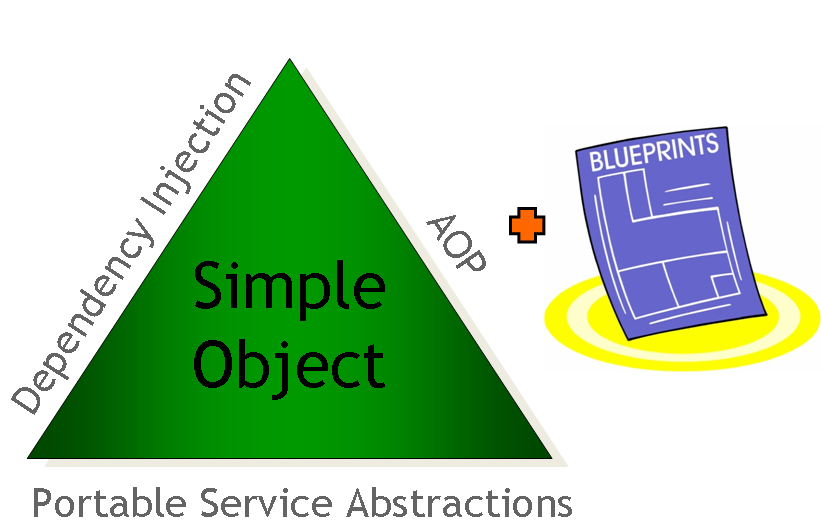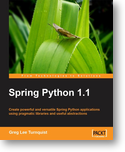3. The IoC container¶
Inversion Of Control (IoC), also known as dependency injection is more of an architectural concept than a simple coding pattern.
The idea is to decouple classes that depend on each other from inheriting other dependencies, and instead link them only at the interfacing level. This requires some sort of 3rd party software module to instantiate the concrete objects and “inject” them into the class that needs to call them.
In Spring, there are certain classes whose instances form the backbone of your application and that are managed by the Spring IoC container. While Spring Java calls them beans, Spring Python and Spring for .NET call them objects. An object is simply a class instance that was instantiated, assembled and otherwise managed by a Spring IoC container instead of directly by your code; other than that, there is nothing special about a object. It is in all other respects one of probably many objects in your application. These objects, and the dependencies between them, are reflected in the configuration meta-data used by a container.
Note
In early 2004, Martin Fowler asked the readers of his site: when talking about Inversion of Control: “the question is, what aspect of control are [they] inverting?”. Fowler then suggested renaming the principle (or at least giving it a more self-explanatory name), and started to use the term Dependency Injection. His article then continued to explain the ideas underpinning the Inversion of Control (IoC) and Dependency Injection (DI) principle.
If you need a decent insight into IoC and DI, please do refer to said article : http://martinfowler.com/articles/injection.html.
The following diagram demonstrates a key Spring concept: building useful services on top of simple objects, configured through a container’s set of blueprints, provides powerful services that are easier to maintain.

3.1. External dependencies¶
XML-based IoC configuration formats use ElementTree which is a part of Python’s stantard library in Python 2.5 and newer. If you use Python 2.4 you can download ElementTree from here. YamlConfig requires installation of PyYAML which may be found here. No additional dependencies needs be installed if you choose PythonConfig.
3.2. Container¶
A container is an object you create in your code that receives the definitions for objects from various sources. Your code goes to the container to request the object, and the container then does everything it needs to create an instance of that.
Depending on the scope of the object definition, the container may create a new instance right there on the spot, or it may fetch a reference to a singleton instance that was created previously. If this is the first time a singleton-scoped object is requested, is created, stored, and then returned to you. For a prototype-scoped object, EVERY TIME you request an object, a new instance is created and NOT stored in the singleton cache.
Containers depend on various object factories to do the heavy lifting of construction, and then itself will set any additional properties. There is also the possibility of additional behavior outside of object creation, which can be defined by extending the ObjectContainer class.
The reason it is called a container is the idea that you are going to a central place to get your top level object. While it is also possible to get all your other objects, the core concept of dependency injection is that below your top-most object, all the other dependencies have been injected and thus not require container access. That is what we mean when we say most of your code does NOT have to be Spring Python-aware.
Note
Pay special note that there is no fixed requirement that a container actually be in a certain location. While the current solution is memory based, meaning your objects will be lost when your application shuts down, there is always the possibility of implementing some type of distributed, persistent object container. For example, it is within the realm of possibilities to implement a container that utilizes a back-end database to “contain” things or utilizes some distributed memory cache spread between nodes.
3.2.1. ObjectContainer vs. ApplicationContext¶
The name of the container is ObjectContainer. Its job is to pull in object meta-data from various sources, and then call on related object factories to create the objects. In fact, this container is capable of receiving object definitions from multiple sources, each of differing types such as XML, YAML, Python code, and other future formats.
The following block of code shows an example of creating an object container, and then pulling an object out of the container.:
# TODO: Use YUI here
from springpython.context import ApplicationContext
from springpython.config import XMLConfig
container = ApplicationContext(XMLConfig("app-context.xml"))
service = container.get_object("sampleService")
The first thing you may notice is the fact that ApplicationContext was used instead of ObjectContainer. ApplicationContext is a subclass of ObjectContainer, and is typically used because it also performs additional pre- and post-creational logic.
For example, any object that implements ApplicationContextAware will have an additional app_context attribute added, populated with a copy of the ApplicationContext. If your object’s class extends ObjectPostProcessor and defines a post_process_after_initialization, the ApplicationContext will run that method against every instance of that object.
If your singleton objects hold references to some external resources, e.g. connections to a resource manager of some sort, you may also want to subclass springpython.context.DisposableObject to have a means for the resources to get released. Any singleton subclassing DisposableObject may define a destroy method which is guaranteed to be executed on ApplicationContext shutdown. An alternative to creating a destroy method is to define the destroy_method attribute of an object which should be a name of the custom method to be invoked on ApplicationContext shutdown. If an object defines both destroy and destroy_method then the former will take precedence. It is an error to extend DisposableObject without providing either destory or destroy_method. If this occurs, an error will be written to Spring Python logs when the container shuts down.
3.2.2. Scope of Objects / Lazy Initialization¶
Another key duty of the container is to also manage the scope of objects. This means at what time that objects are created, where the instances are stored, how long before they are destroyed, and whether or not to create them when the container is first started up.
Currently, two scopes are supported: SINGLETON and PROTOTYPE. A singleton-scoped object is cached in the container until application shutdown. A prototype-scoped object is never stored, thus requiring the object factory to create a new instance every time the object is requested from the container.
The default policy for the container is to make everything SINGLETON and also eagerly fetch all objects when the container is first created. The scope for each object can be individually overriden. Also, the initialization of each object can be shifted to “lazy”, whereby the object is not created until the first time it is fetched or referenced by another object.
3.2.3. Configuration¶
Spring Python supports different formats for defining objects.
In the spirit of Spring JavaConfig and a blog posting by Rod Johnson, the PythonConfig format has been defined. By extending PythonConfig and using the @Object Python decorator, objects may be defined with pure Python code in a centralized class.
XMLConfig (see the XSD spec) closely models the original Spring Java version. It has support for referenced objects, inner objects, various collections (lists, sets, frozen sets, tuples, dictionaries, and Java-style props), and values.
Spring Python also has a YAML-based parser called YamlConfig.
Spring Python is ultimately about choice, which is why developers may extend the springpython.config.Config class to define their own object definition scanner. By plugging an instance of their scanner into ApplicationContext, definitions can result in instantiated objects.
Note
This project first began using the format defined by PyContainer, a now inactive project. The structure has been captured into an XSD spec. This format is primarily to support legacy apps that have already been built with Spring Python from its inception. There is no current priority to extend this format any further. Any new schema developments will be happening with XMLConfig and YamlConfig.
You may be wondering, amidst all these choices, which one to pick? Here are some suggestions based on your current solution space:
- New projects are encouraged to pick either PythonConfig, XMLConfig, or YamlConfig, based on your preference for pure Python code, XML, or YAML.
- Projects migrating from Spring Java can use SpringJavaConfig to ease transition, with a long term goal of migrating to XMLConfig, and perhaps finally PythonConfig.
- Apps already developed with Spring Python can use PyContainerConfig to keep running, but it is highly suggested you work towards XMLConfig.
- Projects currently using XMLConfig should be pretty easy to migrate to PythonConfig, since it is basically a one-to-one translation. The pure Python configuration may turn out much more compact, especially if you are using lists, sets, dictionaries, and props.
- It should also be relatively easy to migrate an XMLConfig-based configuration to YamlConfig. YAML tends to be more compact than XML, and some prefer not having to deal with the angle-bracket tax.
